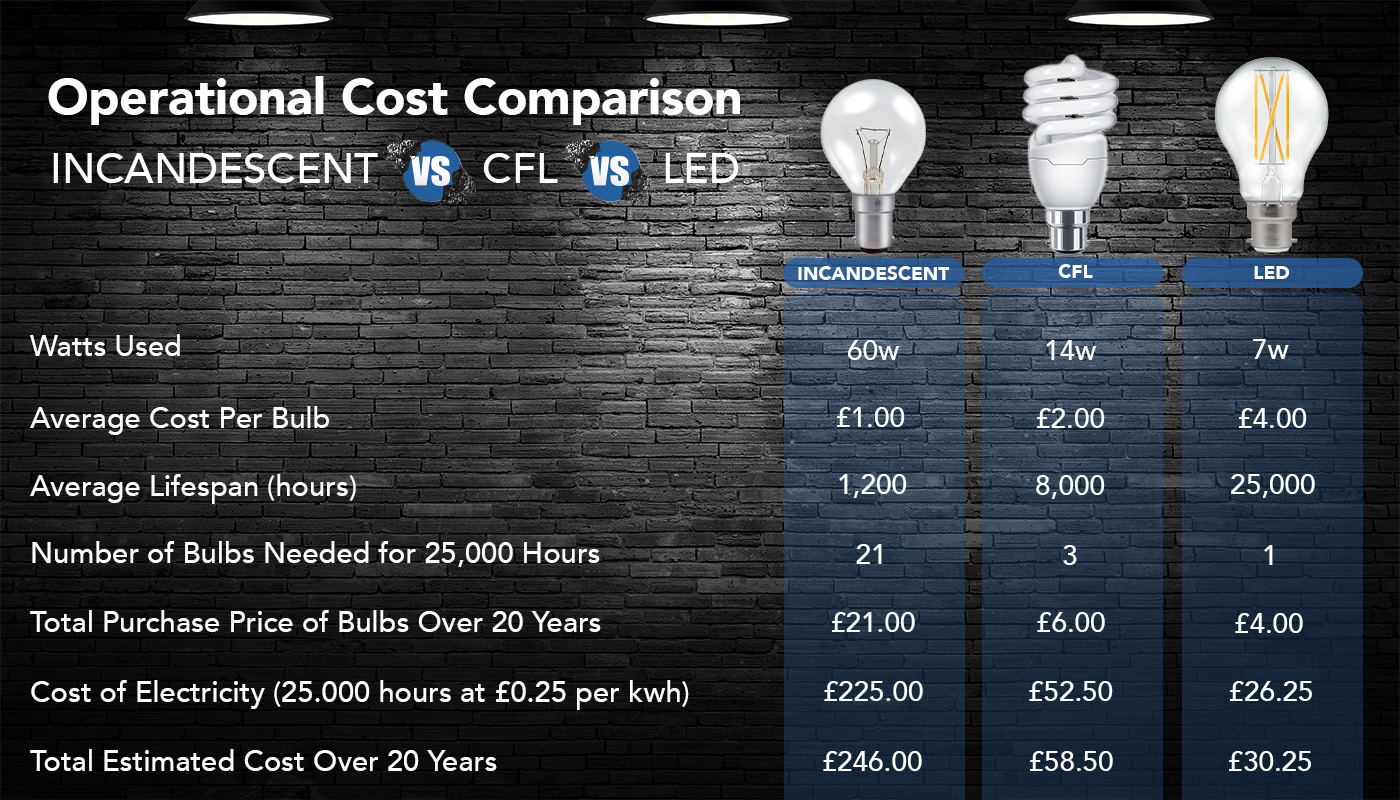Comparing LED, CFL, and Incandescent Bulbs: Which is Best?


Comparing LED, CFL, and Incandescent Bulbs: Which is Best?
Chapters
1. Introduction
2. Understanding the Basics of Light Bulb Types
- Incandescent Bulbs
- Compact Fluorescent Lamps (CFLs)
- Light Emitting Diodes (LEDS)
- Upfront Costs
- Operating Costs
- Total Cost of Ownership
- Energy Consumption
- Disposal and Toxicity
5. Light Quality and Performance
- Colour Temperature
- Brightness and Dimming
Introduction
When it comes to choosing the right light bulbs for your home or business, understanding the differences between LED, CFL, and incandescent bulbs is crucial. Each type of bulb offers distinct advantages and disadvantages, impacting energy efficiency, longevity, cost, and light quality. The right choice can not only enhance the ambience of your space but also lead to significant savings on your energy bills and reduce your environmental footprint.
Incandescent bulbs have been the traditional choice for decades, known for their warm, inviting glow. However, their relatively short lifespan and higher energy consumption have led to the development of more efficient alternatives.
Compact Fluorescent Lamps (CFLs) emerged as a more energy-efficient option compared to incandescent bulbs. They use less power and last longer, making them a popular choice for those looking to reduce energy costs. However, they contain small amounts of mercury, requiring careful disposal, and their light quality can sometimes be harsh or flicker.
Light Emitting Diode (LED) bulbs represent the latest advancement in lighting technology. They are highly energy-efficient, long-lasting, and available in a wide range of colours and brightness levels. Initially more expensive, their cost has decreased over time, making them a viable option for both residential and commercial use. LEDs also offer innovative features like smart connectivity and colour-changing capabilities, further enhancing their appeal.
In this blog post, we’ll compare these three types of bulbs across various parameters to help you determine which is best for your needs. We’ll delve into aspects such as light quality, performance, energy efficiency, cost, and environmental impact. Whether you're looking to create a cosy living room atmosphere, a productive workspace, or an energy-efficient business environment, this guide will provide the insights you need to make an informed decision.
Understanding the Basics of Light Bulb Types
Incandescent Bulbs
Incandescent bulbs are the traditional type of light bulb that has been around for more than a century. They work by passing an electric current through a thin filament, which then heats up and produces light.
Advantages of Incandescent Bulbs:
- Warm Light Quality: Incandescent bulbs emit a warm, pleasant light that is often described as more natural and comforting.
- Low Initial Cost: They are inexpensive to purchase upfront.
- Dimmable: Most incandescent bulbs are fully dimmable without the need for special dimmers.
Disadvantages of Incandescent Bulbs:
- Energy Inefficiency: These bulbs are the least energy-efficient, converting only about 10% of the energy they use into light, with the rest wasted as heat.
- Short Lifespan: They typically last about 1,000 hours, much shorter than LEDs and CFLs.
- Higher Operating Cost: Due to their inefficiency, they cost more to operate over time.
Compact Fluorescent Lamps (CFLs)
CFLs are a type of fluorescent lamp designed to replace incandescent bulbs. They consist of a tube filled with gas and a small amount of mercury, which produces ultraviolet light when electrified. This light then excites a phosphor coating inside the tube, emitting visible light.
Advantages of CFLs:
- Energy Efficiency: CFLs use about 70-80% less energy than incandescent bulbs.
- Longer Lifespan: They last about 8,000 to 10,000 hours, significantly longer than incandescent bulbs.
- Cost Savings: Although they cost more upfront than incandescent bulbs, they save money over time due to their lower energy consumption.
Disadvantages of CFLs:
- Warm-Up Time: CFLs can take a few seconds to reach full brightness.
- Mercury Content: They contain a small amount of mercury, requiring careful disposal and posing an environmental hazard if broken.
- Light Quality: Some users find the light quality of CFLs less pleasant than that of incandescent bulbs.
Light Emitting Diodes (LEDs)
LEDs are the most modern type of light bulb, using semiconductor technology to emit light when an electric current passes through them.
Advantages of LEDs:
- Highest Energy Efficiency: LEDs use about 75-80% less energy than incandescent bulbs and about 20-30% less than CFLs.
- Longest Lifespan: They can last up to 25,000 to 50,000 hours, significantly outlasting both incandescent and CFL bulbs.
- Durability: LEDs are more resistant to shock, vibration, and extreme temperatures.
- Instant Brightness: They turn on instantly to full brightness with no warm-up time.
- Environmentally Friendly: They contain no mercury and have a smaller environmental footprint.
Disadvantages of LEDs:
- Higher Initial Cost: LEDs are more expensive upfront compared to incandescent and CFL bulbs.
- Dimming Compatibility: Not all LEDs are compatible with existing dimmer switches without potential flickering or reduced lifespan.
Comparing the Costs
Upfront Costs
- Incandescent Bulbs: Typically the cheapest, costing around £1 to £2 per bulb.
- CFL Bulbs: Moderately priced, usually between £2 to £3 per bulb.
- LED Bulbs: The most expensive upfront, ranging from £2 to £5 or more per bulb.
Whilst the price of LED lighting is constantly dropping certain factors like High CRI (colour rendering index) life span and dimmability can increase the price of a bulb.
Operating Costs
Considering the energy efficiency and lifespan of each bulb type, LEDs offer the lowest operating costs over time, despite their higher initial price. CFLs also provide significant savings compared to incandescent bulbs.
Total Cost of Ownership
When factoring in both the purchase price and the operating costs, LEDs generally provide the best value for money in the long run, followed by CFLs and then incandescent bulbs.


Environmental Impact
Energy Consumption
LEDs are the most energy-efficient option, followed by CFLs and incandescent bulbs. Using LEDs reduces the overall electricity demand, which can lower greenhouse gas emissions from power plants.
Disposal and Toxicity
- Incandescent Bulbs: These bulbs do not contain hazardous materials and are safe to dispose of in regular trash.
- CFL Bulbs: Contain mercury, which requires special handling and disposal to avoid environmental contamination.
- LED Bulbs: Free of hazardous chemicals like mercury, but they do contain electronic components that should be recycled properly.
Light Quality and Performance
Colour Temperature
Incandescent Bulbs: Incandescent bulbs are known for their warm, yellowish light, typically around 2700K. This warm hue is often associated with a cosy and inviting atmosphere, making incandescent bulbs a popular choice for living rooms and bedrooms. Their consistent and familiar light quality has been a standard for many years, providing a comforting and aesthetically pleasing environment.
CFL Bulbs: Compact Fluorescent Lamps (CFLs) come in a variety of colour temperatures ranging from warm to cool (2700K to 6500K). This flexibility allows CFLs to be used in different settings depending on the desired ambience. Warm white CFLs (2700K-3000K) can create a similar feel to incandescent bulbs, while cooler temperatures (4000K-6500K) are better suited for task lighting and workspaces due to their brighter, more energising light.
LED Bulbs: Light Emitting Diode (LED) bulbs offer the most extensive range of colour temperatures, from very warm (2000K) to very cool (6500K). Some LED bulbs even come with colour-changing options, allowing users to customise their lighting environment to any mood or activity. This versatility makes LEDs suitable for any room in the house, providing both the warm ambience of incandescent bulbs and the bright, crisp light needed for workspaces and outdoor areas.
Brightness and Dimming
Incandescent Bulbs: One of the key advantages of incandescent bulbs is their natural dimming capability. They offer a smooth transition from full brightness to a dim glow without any flickering or buzzing. This smooth dimming ability makes them ideal for creating a relaxed atmosphere, as they can be easily adjusted to suit different times of the day and activities.
CFL Bulbs: Dimming can be a challenge with CFL bulbs. While some CFLs are designed to be dimmable, they often do not perform as smoothly as incandescent bulbs. Dimmable CFLs may flicker or buzz when not at full brightness, and they generally have a more limited dimming range. Additionally, not all dimmer switches are compatible with CFL bulbs, which can further complicate their use in dimmable fixtures.
LED Bulbs: LED bulbs are available in dimmable versions, offering a good alternative to incandescent bulbs in terms of dimming capabilities. However, the performance of dimmable LEDs can vary depending on the compatibility with the existing dimmer switches. Using a dimmer switch specifically designed for LED bulbs can ensure a smoother dimming experience. Additionally, some advanced LED systems offer smart dimming options that can be controlled via apps or voice commands, providing even greater flexibility and control over the lighting environment.
Conclusion: Which Bulb is Best?
Choosing the best light bulb depends on your specific needs and priorities:
- If you prioritise energy efficiency and long-term cost savings: LEDs are the best choice due to their low energy consumption and long lifespan.
- If you need a budget-friendly option for the short term: Incandescent bulbs might be suitable but be aware of their higher operating costs and shorter lifespan.
- If you want to balance cost and efficiency: CFLs can be a good compromise, offering decent energy savings and a longer lifespan than incandescent bulbs, at a moderate upfront cost.
- Ultimately, LEDs offer the best overall value, performance, and environmental benefits for most applications. They are ideal for investing in a sustainable and cost-effective lighting solution.
Need assistance in finding the perfect lighting solution for your needs?
This is our speciality. Our experienced team has witnessed the evolution of the mentioned lighting technologies.
With our track record in successful LED conversion projects, rest assured we will recommend only the best solutions for your needs.